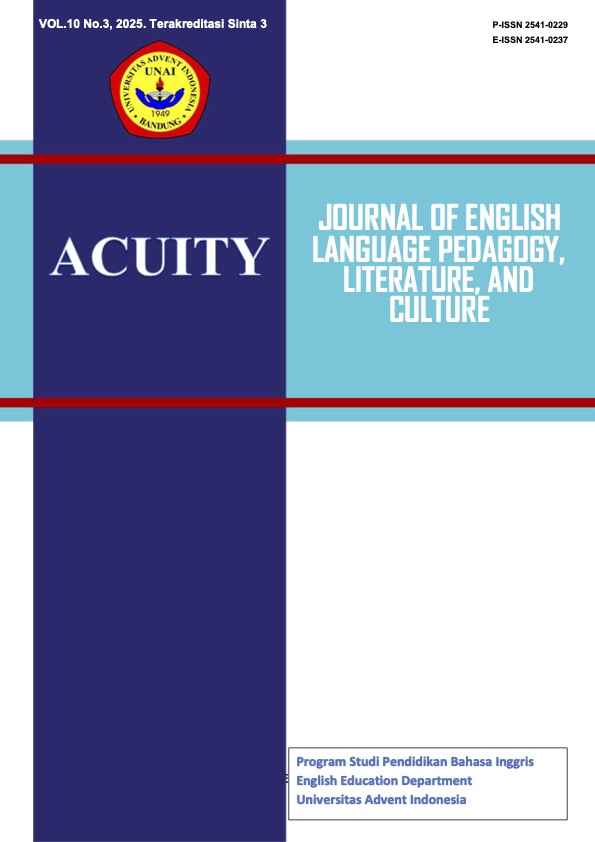The Realization of Assertive and Directive Speech Acts in Apple’s Instagram Captions
Keywords:
Keywords: Instagram, pragmatic, speech actAbstract
This research aims to analyze assertive and directive speech acts in “Apple” official account captions on Instagram using Searle’s theory related to environmental topics, particularly those promoting nature. With the increasing role of social media in corporate communication, companies like Apple have leveraged platforms such as Instagram to engage with their audience and raise awareness of important environmental. By examining the language used in Apple's captions, this study aims to explore how the company employs various communication strategies to influence public attitudes and encourage positive behavior toward environmental sustainability. Through a descriptive qualitative approach, 56 speech acts from the 44 captions were analyzed. The most frequently used speech act by Apple’s captions on Instagram is assertive acts, which are used 50 times and they are asserting (38%), stating (28%), informing (22%), describing (8%), claiming and giving opinion (2%) then directive acts only 6 times. It is utilized to inform, motivate, and provoke thought among followers. From the whole result, this research highlights the role of social media in shaping consumer perceptions and fostering environmental responsibility. The findings provide valuable insights into the effectiveness of language as a tool for building trust and ongoing communication to drive environmental action
Keywords: Instagram, pragmatic, speech act
Downloads
References
Austin, J. L. (1962). How to do things with words. Clarendon Press.
Basra, S. M., & Thoyyibah, L. (2017). A speech act analysis of teacher talk in an EFL classroom. International Journal of Education, 10(1), 73-81. https://doi.org/10.17509/ije.v10i1.6848
Creswell, J. W., & Creswell, J. D. (2022). Research design: Qualitative, quantitative, and mixed methods approaches (6th ed.). SAGE Publications.
Derrida, J. (1978). Writing and Difference. University of Chicago Press.
Dewi, A. P., Nur, T., Machdalena, S., & Shmelkova, V. V. (2024). Illocutionary speech acts on Balinese hospitality advertising discourse in Russian: A pragmatic study. Theory and Practice in Language Studies, 14(1), 192–201. https://doi.org/10.17507/tpls.1401.23
Faridi, Abdurrachman., & Seful Bahri. (2016). Developing english islamic narrative story reading model in islamic junior high school. AWEJ: Arab World English Journal, 7(2), 224-243. https://dx.doi.org/10.24093/awej/vol7no2.15
Galloway, S. (2018). The Four: The Hidden DNA of Amazon, Apple, Facebook, and Google. Portfolio.
Hidayat, H., Issy Yuliasri., Dwi Rukmini., & Widhiyanto Widhiyanto. (2020). Promoting critical literacy in academic reading class: EFL learners’ activity exploration. ISET: International Conference on Science, Education and Technology, 715-722. https://proceeding.unnes.ac.id/index.php/iset
Hokky, L. A., & Bernarto, I. (2021). The role of brand trust and brand image on brand loyalty on Apple iPhone smartphone users in DKI Jakarta. Enrichment: Journal of Management, 12(1), 474-482.
Kaburise, P. (2011). Speech act theory and communication: A univen study. Cambridge Scholars Publishing
Gunawan, A., Desi, P., & Hikmaharyanti, A. (2024). Expressive illocutionary acts on Manchester United Instagram account. Humanis Journal of Arts and Humanities, 28(1), 122-131. https://doi.org/10.24843/jh.2024.v28.i01.p011
Kadek Jessica Sarindra Dwije, N., Wayan Sukarini, N., & Luh Sutjiati Beratha, N. (2024). Types of directive illocutionary acts in barbie movie. International Journal of Education and Literature, 3(2), 44-54. https://doi.org/10.55606/ijel.v3i2.109
Konrad, K., et al. (2022). Are iPhones really better for privacy? a comparative study of iOS and Android apps. Proceedings on Privacy Enhancing Technologies, (2), 6-24. https://doi.org/10.2478/popets-2022-0033
Lee, T. S. (2020). Requests and recommendations in Instagram posts: A speech act perspective. Discourse & Communication, 14(4), 334-348.
Nguyen, Hoang-Tien. (2020). Comparative analysis of international marketing strategies of Apple and Oppo. International Journal of Research in Marketing Management and Sales, 1(2), 51-56 http://dx.doi.org/10.33545/26633329.2019.v1.i2a.17
Rosyida, A. N., Fauzi, E. M., Sunan, U., & Djati, G. (2020). A speech act analysis on Alexandria Ocasio-cortez’s 2018 political campaign advertisement. PROJECT: Professional Journal of English Education, 3(2), p 299-304. https://doi.org/10.22460/project.v3i2.p299-304
Searle, J. R. (1969). Speech acts: An essay in the philosophy of language. Cambridge University Press.
Searle, J. R. (1976). A classification of illocutionary acts. Language in Society, 5(1), 1–23. https://doi.org/10.1017/S0047404500006837
Searle, J. R. (1979). Expression and meaning: Studies in the theory of speech acts. Cambridge University Press.
Searle, J. R. (1996). The construction of social reality. Free Press.
Tuten, T. L., & Solomon, M. R. (2017). Social Media Marketing. Pearson.
Yule, G. (1996). Pragmatics. Cambridge University Press.

















